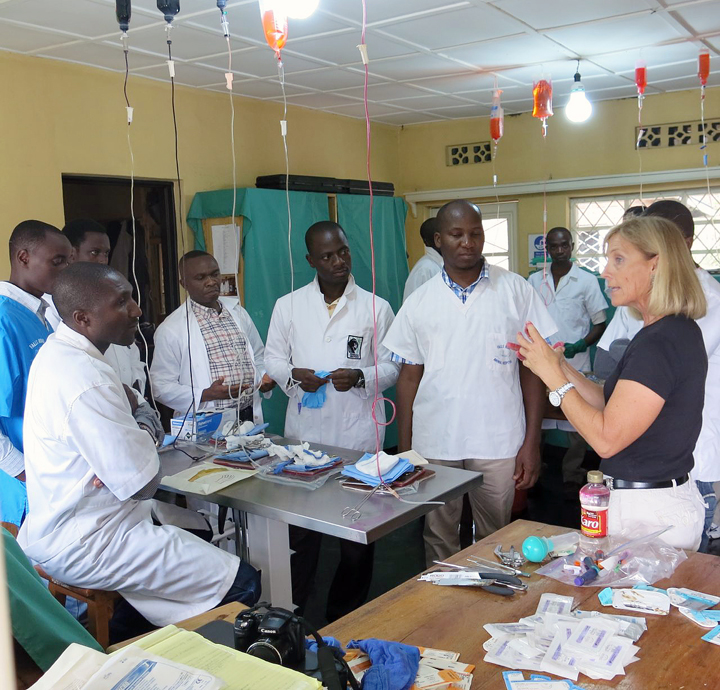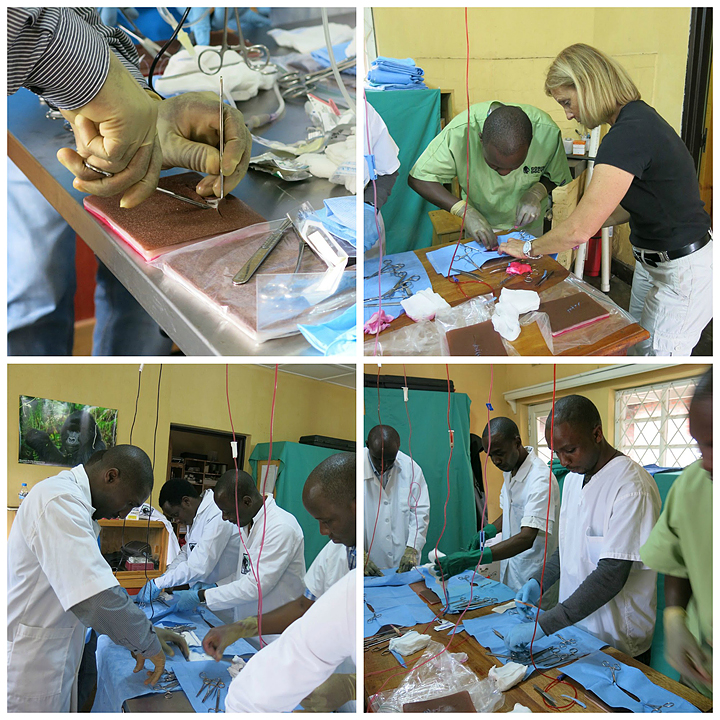Veterinary Surgeon Dr. Donna Shettko Gives Seminar on Wound Healing & Life-Saving Surgery
By Gorilla Doctors Staff on Monday, December 29th, 2014 in Blog.The Gorilla Doctors team would like to extend our gratitude to Dr. Donna Shettko, who recently met with our entire veterinary team at our Musanze, Rwanda headquarters to give a seminar on wound healing, amputation and suture techniques during monthly rounds.

Dr. Donna Shettko speaks with Gorilla Doctors field veterinarians in the Musanze laboratory.
Dr. Donna kindly agreed to write about her experience, and her history with Gorilla Doctors Regional Manager Dr. Jan Ramer here:
“I met my friend and study buddy Jan Ramer the second day of veterinary school at the University of Wisconsin, Madison and to my good fortune, we have remained friends since that first meeting. My friendship with Jan and my interest in One Health Medicine is what brought me to Rwanda and the Gorilla Doctors.
My name is Donna Shettko and I am a large animal surgeon and a nurse practitioner/physician assistant. I completed my NP/PA training so that I could better understand human disease and zoonosis in order to provide comprehensive medical and veterinary care. Recently, I have been teaching surgical skills using simulation models in an educational program for validating and maintaining practice competencies. Dr. Dean Hendrickson at Colorado State University developed these simulation models; they have the look, feel, tissue tension and tissue characteristics of real skin… the models also bleed which provides the opportunity to practice hemostatic techniques. With the exciting opportunity to work with Jan in Rwanda and share my surgical skills with the Gorilla Doctors field veterinarians, I made my way to Rwanda.
I gave my surgical skills seminar during the Gorilla Doctors monthly rounds, when all of the field veterinarians from Uganda, DRC and Rwanda convene at the headquarters in Musanze to discuss recent cases, current issues and future plans. My seminar began with a series of talks, the first being a review of sterile procedures such as gloving and draping. This talk prompted an active discussion on what surgical scrub would be best to use in the field. Another topic that was important to cover was amputation techniques: while amputation is usually not necessary, snares can pose a threat to the gorilla’s limbs and reviewing the procedures would be useful for the field vets.
The principles of wound healing, wound assessment and different wound healing therapeutics were also discussed with the focus on what would be useful in the gorilla. In preparation for the surgical skills lab, the different suture patterns, tissue and instrument handling and the different methods of hemostasis were discussed. In the lab, suture patterns (which included simple interrupted, simple continuous, subcuticular, vertical and horizontal mattress) were practiced using the simulation models. After practicing the suture patterns, an incision was made into the models which caused bleeding and prompted the need to practice ligating the vessels for hemostasis. The models remained behind so that the Gorilla Doctors can continue to practice the surgical techniques as needed.

Gorilla Doctors field veterinarians practice suture techniques with Dr. Donna Shett
The Gorilla Doctors were a great, engaging group of veterinarians and I really enjoyed conducting the seminar. They were eager to exchange ideas and discuss cases where they could implement the skills if given a similar situation. Their dedication to learning was evident in their energetic enthusiasm in practicing the surgical skills with the simulation models.
It was a pleasure and honor to work with veterinary professionals who are dedicated and committed to providing the best medical care to their patients. The work of the Gorilla Doctors is very important in the preservation and conservation of eastern gorillas… they are truly making a difference.”


 Donate
Donate